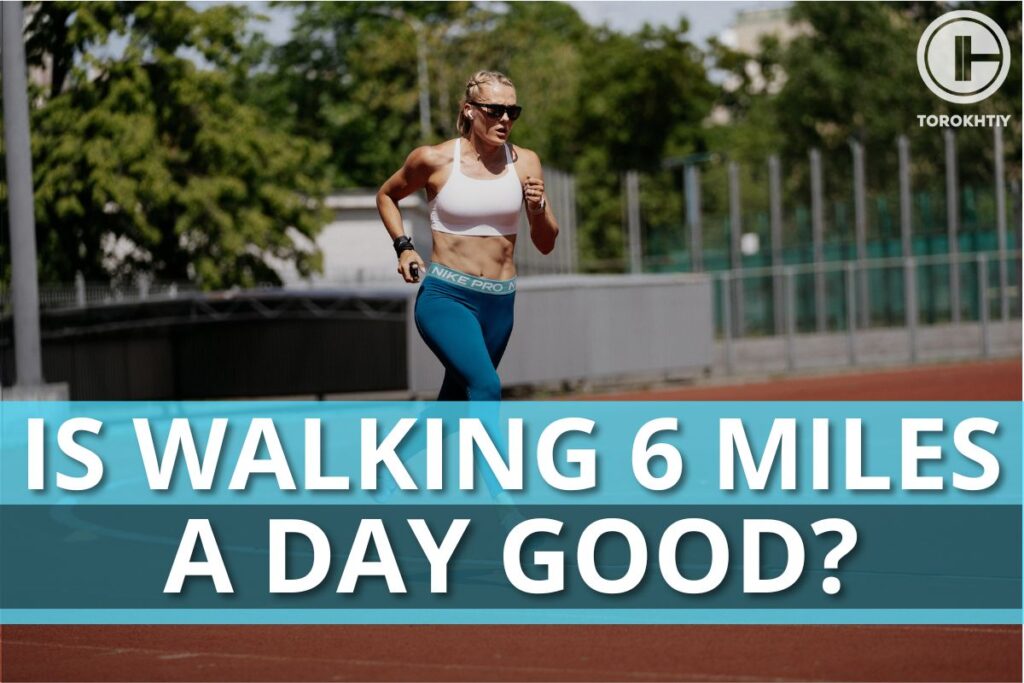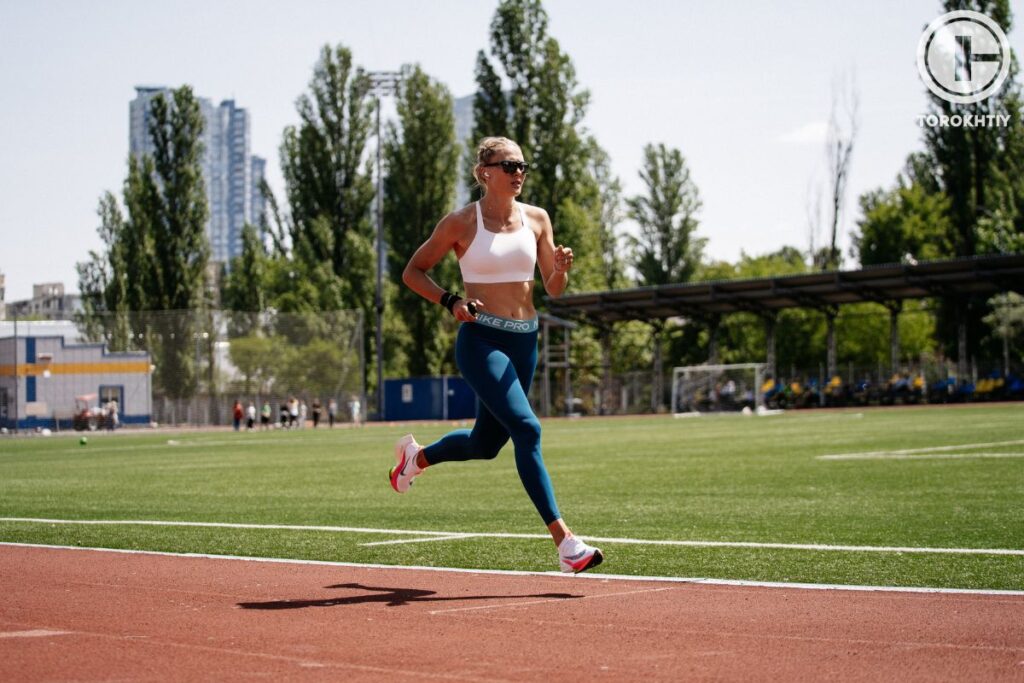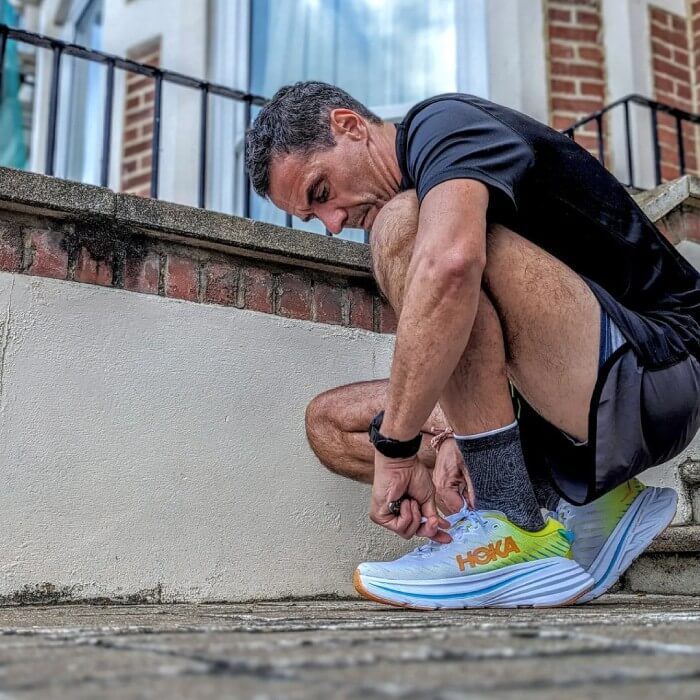Is Walking 6 Miles a Day Good? Exploring the Benefits
Author:
Unlock your full potential by engaging with our experts and community! Have questions about your fitness journey or looking for expert advice on weightlifting techniques? Don’t hesitate — leave a comment below and Oleksandr Zagrebelnyi will provide a personalized answer and insights to help you reach your goals.
Torokhtiy is reader-supported. Some links are affiliate links, and we may earn a commission at no extra cost to you. See our disclosure page for details.
These days, it’s normal to sit around all day and have packed schedules, and work commitments don’t leave a lot of time for the gym. But there’s an accessible and easy alternative: taking a walk. Is walking 6 miles a day good, and should you give it a try? That’s exactly what we’ll be discussing! Walking 6 miles a day may sound intimidating, but once you get used to it, it becomes second nature.
But what walking 6 miles a day results in? Are there any real and tangible benefits? Well, when you hear about either of these, you’ll be excited for your daily walks. Most people think about weight loss first, but it is a lot more than a way to manage your weight: it’s going to do wonders for your health overall, from the cardiovascular system to your mental health.
This can be your new go-to health strategy, so, whether you’re kickstarting your fitness journey or just want to learn about the benefits of long walks – keep reading.
Walking 6 miles a day can have a lot of health benefits: it improves cardiovascular fitness, helps you manage your weight, and boosts your mental well-being. Still, there are factors that need to be considered, like individual fitness level and joint health.

Walking 6 miles a day: should you start?
This can be a very healthy choice for a lot of people. It’s simple, there’s no need to pay for a gym membership, you don’t have to deal with bulky equipment…
Basically, it’s a very easy way to stay active. Walking is a low-impact exercise, which means it’s kind to your joints, and it can help keep your heart and weight in check. It’s also very relaxing and can do a lot for your mental health; it lets you clear your mind and enjoy your environment.
You’ll even see dedicated runners take a break from running and go for a relaxing 6-mile walk. Why, you ask? It’s simple: walking is a great way to stay active, get a change of pace, and let your muscles recover at the same time.
Still, this is not ideal for everyone, and whether a 6-mile walk is good depends on you. If you’re new to exercise in general or have health issues, you may want to talk to your doctor before starting to take long walks.
Follow us!

Free!
Get a 2-week Weightlifting Program as a bonus for the subscription to kickstart your training plan!

Free!
How Far Is 6 Miles?
6 miles (9.7 kilometers) is quite the distance if you’re on foot. To put it in perspective, 6 miles would be close to a 2-hour walk (assuming you walk at about 3 miles per hour). In terms of steps, the average person takes about 2000 steps per mile, so a 6-mile walk would be about 12000 steps.
If you’re a runner, covering 6 miles in one go can be a real challenge, especially if your priority is speed. It’s like running a 10K race, which is popular with recreational runners. If you’re running for 6 miles, you’ll take about 9,000 to 10,800 steps, depending on your biomechanics and pace.
Tips From the Champ
To make things simple and seamless when gauging the time it’ll take you to complete the 6-mile walk, get a fitness tracker. This tool is designed to keep track of useful info during your walk, e.g. time, total steps, calories burned, etc.
Running Coach Nike Run Club Kyiv
How Long Does It Take to Walk 6 Miles?
Apart from “how far is 6 miles,” the most frequent question related to this topic is probably “how long does it take to walk 6 miles?” Well, it depends on things like your gender, your pace, and age.
A person that’s walking at a moderate pace of around 3 miles per hour will cover 6 miles in about 2 hours. But keep in mind, this should be considered as an average guideline and not a one-size-fits-all rule.
Gender is one of the factors that’s going to play a role, because some studies have suggested that men usually walk a bit faster than women do. Of course, your personal pace is also important to consider because we all have different paces we like to walk at. Something that’s average for you might be too slow or too fast for someone else, so this factor varies a lot.
You need to keep age in mind as well: if you’re younger, it’s safe to assume you’ll walk faster than someone older because of the difference in muscle strength and endurance.
So, you see, there’s no chance of giving a straightforward answer to this question, and the only answer anyone can give you is, it depends. But that’s a good thing, because it means that you can adapt this goal to your preferences and abilities, which makes a 6-mile walk achievable for a lot of people.
| FACTOR | AVERAGE TIME | ESTIMATED RANGE | INFLUENCE ON WALKING SPEED |
|---|---|---|---|
| Gender | Variable | Men usually walk slightly faster than women. | Gender can influence walking speed, but the impact varies. |
| Walking Pace | 2 to 4 hours | Faster pace shortens time / slower pace lengthens it. | The walking pace you choose is a major determinant of time. |
| Age | Variable | Younger people walk faster, and older people tend to walk slower. | Younger people tend to walk faster because they have more endurance, and their muscles are stronger. |
When going for a 6-mile walk as a complete beginner, rely on gradual progression. Build up to 6 miles slowly and at your own pace. If you feel that you won’t be able to accomplish it on the first day – stop, rest, and try again tomorrow!
8 Benefits of Walking 6 Miles a Day
Walking is a great way to stay active without putting your body through something too intense, but 6 miles is quite a lot. Why should you put yourself through it? Is it worth the time and effort?
There are many benefits of walking 6 miles a day. Let’s check them out!
✅ Better Cardiovascular Health
If you decide on walking six miles a day, you will improve your cardiovascular fitness. This is a low-impact way to strengthen your heart, lower blood pressure, and improve circulation. Consequently, it reduces the risk of heart diseases and stroke.
✅ Weight Management
Generally, walking is a great way to keep your weight in check. But if you walk 6 miles, you’ll burn even more calories and be able to maintain and lose weight easier. It will also help regulate your metabolism.
✅ More Endurance
Regular long walks improve your stamina, and as you get used to consistently covering 6 miles, you’ll notice increased endurance. This can boost your overall energy level.
✅ Joint-Friendly
Walking is a lot easier on your joints than running. It’s the perfect way to stay active without risking joint pain and injury. This is why walking is suitable for people of all ages.
✅ Mental Health
The benefits are not just physical – your mental health will love long walks, too. Walking releases endorphins, which are natural mood lifters, and will allow you to clear your mind and relax. A long walk can help you reduce stress, anxiety, and depression, which, unfortunately, are becoming more common these days.
✅ Better Sleep
If you’re physically active on a regular basis, your sleep quality will improve. Daily long walks will help regulate your sleep pattern and it will make it easier for you to fall asleep at night.
✅ Denser Bones
Weight-bearing exercises help improve bone density, and walking is one of those exercises. This is very important when it comes to bone health, especially as we age and the risk of osteoporosis increases.
✅ Less Risk of Chronic Diseases
A 6-mile daily walk can reduce the risk of chronic diseases like diabetes, high blood pressure, and certain types of cancer. Think of it as prevention that contributes to a longer and healthier life.
Tips From the Champ
If you want to maximize the benefits of your 6-mile walk, add variety to your walking routine. Mix slow strolls with brisk paces. Change the usual routes with varying terrain. Different elevations and different surfaces can completely change your walk.
Running Coach Nike Run Club Kyiv
Walking 6 Miles a Day for Weight Loss
It’s no surprise that most people are primarily interested in weight loss, since a sedentary lifestyle contributes to weight gain. Walking 6 miles a day weight loss results can be impressive, but keep in mind that you need to combine your walks with a healthy diet.
To see any kind of tangible results, you’ll need to walk 6 miles a day for 5 to 6 days a week. Rest days are important, so make sure you take your time to let your body recover, but aim to walk for most days of the week.

If you’re a beginner and generally inexperienced when it comes to physical activity, you should start slow and take your walks 2 to 3 days a week. As your fitness level improves, you can up the frequency. Make sure to focus on consistency – you need a steady calorie deficit, because that’s the foundation of weight loss.
After walking 6 miles a day for a month, you will probably notice some visible changes. Weight loss will depend on a lot of things, such as your current weight, diet, and walking pace. A rule of thumb is that a deficit of 3500 calories equals about 1 pound of weight loss. So, if your daily walk burns about 600 to 800 calories, you’ll lose 4 to 5 pounds in a month.
Remember that weight loss isn’t just about the numbers the scale shows, because muscles weigh more than fat. You will start noticing changes in your body composition, like your muscles being more toned and your body fat going down.
Walking 6 miles a day goes beyond the scale. As you accumulate miles, you’ll build endurance and boost your metabolism, which will make it a lot easier to maintain the weight you want.
Walking can also help with cravings and appetite and make you stick to a healthy diet. Plus, don’t forget about the mental health benefits: for a lot of people, stress leads to snacking and junk food. Since walking will help your mental health, you may be less prone to snacking, because you will be in a better mood.
A general simplified rule to losing weight is to burn more calories at the end of the day than the amount you’ve added to your body. You can maximize the calorie burn during your 6-mile walk by increasing your walking pace as well as adding extra encumbrance (in the form of a backpack, or even a weighted vest). And, of course, don’t forget to adjust your diet!
How Many Calories Do You Burn Walking 6 Miles a Day?
It would be great if there was a straightforward answer to this question so you know exactly what to expect, right? Sorry to disappoint, but this is also one of those questions that can only be answered with “it depends.” The number of calories you’ll burn will depend on your pace, weight, and terrain.
For instance, if you weigh 155 pounds and keep a steady pace of 3 miler per hour, you’ll burn close to 314 calories per hour of walking. So, if you walk for 6 miles, the number of calories you will burn will be about 628.
But if you weigh more, you’ll burn more calories, and if you walk faster, you’ll burn even more. So, you see, it really does depend.

Terrain plays a part as well, because walking uphill or on rough terrain is more challenging than walking on the pavement, which means it burns more calories.
So, how many calories does walking 6 miles burn? Even though there’s no concise answer to this question, remember that a 6-mile daily walk can contribute to weight loss a lot. Focus more on your health and the way you feel than on the numbers on the scale.
Calories Burned Based On Body Weight & Walking Speed
| WEIGHT (lbs) | WALKING PACE (mph) | CALORIES BURNED IN 6 MILES |
|---|---|---|
| 155 (average) | 3 | ~ 628 |
| 125 | 3 | ~ 506 |
| 185 | 3 | ~ 750 |
| 205 (overweight) | 3 | ~ 837 |
| 255 (obese) | 3 | ~ 1046 |
| 155 (average) | 4 | ~ 838 |
| 125 | 4 | ~ 671 |
| 185 | 4 | ~ 671 |
| 205 (overweight) | 4 | ~ 1118 |
| 255 (obese) | 4 | ~ 1397 |
6 Tips on How to Get Started Walking 6 Miles a Day
Anyone who decides to include 6-mile walks in their daily routine deserves praise. If you’re one of those people who is getting ready to take long walks – congratulations!
However, starting anything new can be difficult, and staying consistent may seem impossible. There are a few things you can do to make your life (and walks) easier and to make sure you stay on track.
Tips From the Champ
Use a fitness tracker or a calorie-tracking app during your walks. This way, you can get a more accurate estimate of calories burned during and after your 6-mile walk. Also, very importantly, take note of the results each day. This way, you can get a comparison of the difference in burned calories depending on different factors, e.g. walking pace, different terrains, walking with added weight, etc.
Running Coach Nike Run Club Kyiv
1. Realistic Goals
Don’t push yourself too hard and don’t set your expectations too high. If you’re new to long walks, start with a shorter distance and slowly up the distance to 6 miles. If you set realistic goals, it will be a lot easier to stay motivated.
2. Right Footwear
If you go for a long walk, then you need to have comfortable walking or running shoes on. Look for something supportive, cushioned, and of the right size.
3. Warming Up and Stretching
Take a few minutes before each walk to warm up and stretch. This will prepare your muscles for the walk and can also prevent injury.
4. Water and Diet
Dehydration is a serious thing, so carry a bottle of water with you and stay hydrated all the time. Apart from drinking enough water, a balanced diet is also important because it acts as fuel for your walks and helps in recovery.
5. Consistency
In short, set a schedule and stick to it. If you’re not consistent, daily walks will never become your habit and they’ll always feel like a chore, which means it will be a lot easier for you to just give up.
6. Rest
Don’t walk for 6 miles 7 days a week. Take a day or two to rest, allow your muscles to recover, and prevent injuries that come from overtraining.
A great way to make your 6-mile walk more interesting is to listen to music or a podcast via comfortable headphones. This way, you are not only taking care of your health but also being productive! 😀
Hoka Bondi 8
- Material: Breathable and supportive mesh upper
- Sole Material: Full-length EVA midsole for maximum cushioning
- Outsole (tread feature): Durable rubber outsole with a unique lug pattern
- Drop: 4mm
- Season: Suitable for all seasons
- Special Features: Exceptional cushioning and comfort
- Size: Available in various sizes
- Type: Maximum cushioning running shoe
If you want excellent running or walking shoes or just footwear you’ll be comfortable in, you can’t go wrong with the Hoka Bondi 8.
It’s been upgraded and now they have lighter, softer materials and a new extended heel design. The heel design gives a super soft, balanced feeling from th emoment your heel hits the ground to when you push off with your toes.
As far as the weight goes, it’s around 10.80 ounces, and the heel drop is 4 mm. They’re not too heavy and the lower drop is a good balance between cushioning and feeling connected to the ground.
The Bondi 8 is focused on cushioning and keeps things simple. There’s a good amount of support without any extra stuff that you don’t really need and that would only jack up the price. Take the rear crash pad, for example – it makes for a soft, smooth ride, which is perfect if you like to run outdoors.

The upper part is made of engineered mesh, which is breathable and keeps your feet cool and dry. The tongue and collar have memory foam and mold to your foot shape. All of these features make the fit snug but flexible, which is exactly what you would want.
The Bondi 8 is eco-friendly because it uses recyclable materials in parts like the mesh and the sockliner. Plus, the shoes are completely vegan, which (if that’s important to you) is nice!
FAQ
Is walking 6 miles a day too much?
It’s challenging for sure, but generally, it’s manageable and has a lot of benefits. Before you start, though, make sure to speak to your doctor if you’re dealing with any health issues.
Will walking 6 miles a day help lose belly fat?
You can’t target fat loss, but walking 6 miles a day will contribute to calorie deficit, which is what you need to lose weight. This way, you’ll lose fat overall, which means belly fat, too.
Will walking 6 miles a day tone my legs?
Yes, it can help tone your leg muscles over time because it engages the leg muscles, especially quads, hamstrings, and calf muscles.
Is it okay to walk 6 km a day?
This is considered a healthy and moderate exercise that is good for most people. It will provide a lot of cardiovascular and health benefits but won’t strain your body too much.

Conclusion
If you wanted to know if walking 6 miles a day is good, the answer is – yes, it is for most people, and a lot of them have been very successful in their walking 6 miles a day weight loss journey. If your fitness level doesn’t allow you to complete 6 miles, start with a shorter distance and always listen to what your body is telling you.
It’s also good to consult your doctor or a fitness expert before you start, especially if you’re dealing with health issues.
What are your thoughts on this? Have you ever considered giving a 6 mile walk a try? Have you ever tried it? If you have, what tips do you have to offer to people who are just starting out? What other exercises do you combine with walking? Is 6 miles a day good according to your experience?
Leave any tips and opinions in the comments.
Happy walking!
References:
- Janelle Wagnild, Cara Wall-Scheffler, “Energetic Consequences of Human Sociality: Walking Speed Choices among Friendly Dyads,” PLoS ONE 8, no. 10, (2013): e76576, https://www.researchgate.net/publication/258315710_Energetic_Consequences_of_Human_Sociality_Walking_Speed_Choices_among_Friendly_Dyads (accessed Oct. 18, 2023).
- Katherine Zeratsky, “Can I Lose Weight If My Only Exercise Is Walking?” Mayo Clinic, https://www.mayoclinic.org/healthy-lifestyle/weight-loss/expert-answers/walking/faq-20058345 (accessed Oct. 18, 2023).
- Martin Mau, Anders Aaby, Søren Harnow Klausen, Kirsten Kaya Roessler, “Are Long-Distance Walks Therapeutic? A Systematic Scoping Review of the Conceptualization of Long-Distance Walking and Its Relation to Mental Health,” International Journal of Environmental Research and Public Health 18, no. 15 (2021): 7741, https://www.ncbi.nlm.nih.gov/pmc/articles/PMC8345809/ (accessed Oct. 18, 2023).
- S. A. Jebb, M. S. Moore, “Contribution of a Sedentary Lifestyle and Inactivity to the Etiology of Overweight and Obesity: Current Evidence and Research Issues,” Medicine & Science in Sports & Exercise 31, no. 11 (1999): S534-41. https://pubmed.ncbi.nlm.nih.gov/10593524/ (accessed Oct. 18, 2023).
- “Slowing Bone Loss with Weight-Bearing Exercise,” Harvard Medical School, https://www.health.harvard.edu/staying-healthy/slowing-bone-loss-with-weight-bearing-exercise (accessed Oct. 18, 2023).
- “Walking for Exercise,” Harvard School of Public Health, https://www.hsph.harvard.edu/nutritionsource/walking/ (accessed Oct. 18, 2023).
- Photos made by Torokhtiy Weightlifting Team.
Why Trust Us?
With over 20 years in Olympic weightlifting, strength training, nutrition coaching, and general fitness our team does its best to provide the audience with ultimate support and meet the needs and requirements of advanced athletes and professional lifters, as well as people who strive to open new opportunities and develop their physical capabilities with us.
By trusting the recommendations of our certified experts in coaching, nutrition, and sports training programming, as well as scientific consultants, and physiotherapists, we provide you with thorough, well-considered, and scientifically proven content. All the information given in the articles concerning workout programming, separate exercises, and athletic performance, in general, is based on verified data.
The product testing process is described in more detail here.
Oleksandr is a running coach and member of the Nike Run Club coaching team for 8 years. A participant in national and international competitions at distances from one kilometer to the ultra trail. Owner of mountain trail running camps. Nowadays Oleksandr is responsible for creating running training programs for athletes of various levels, coaching personally offline and online, conducts trail running camps in the mountains, participates in competitions.




Still have questions after reading our article? Unlock your full potential by engaging with our experts and community! Don’t hesitate — leave a comment below and Oleksandr Zagrebelnyi will provide a personalized answer and insights to help you reach your goals.